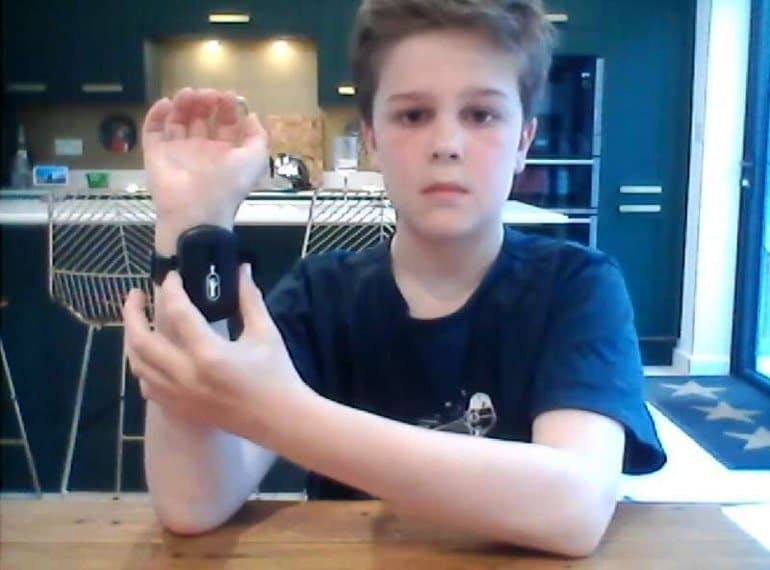Summary: A new wrist device designed to help control symptoms of Tourette syndrome reduces the severity and frequency of tics.
Source: University of Nottingham
The results of the clinical trial of a new wrist device designed to help control the symptoms of Tourette syndrome have shown it significantly reduces the severity and frequency of tics.
The prototype wrist device, which was recently tried out by Lewis Capaldi, delivers electrical pulses to reduce the amount and severity of tics experienced by individuals with Tourette’s and was trialed by 121 people across the UK.
The results have been announced in MedRxiv.
The device has been developed by scientists at the University of Nottingham and spin-out company Neurotherapuetics Ltd who have recently secured £1m in additional funding to commercialize the ‘Neupulse’ device with the aim of having a device and App available within the next 3 years.
Tourette Syndrome (TS) is a neurodevelopmental condition that is usually diagnosed between the ages of eight and 12. It causes involuntary sounds and movements called tics. Tics are repetitive, stereotyped movements and vocalizations that occur in bouts, typically many times in a single day, and are often preceded by a strong urge-to-tic, referred to as a premonitory urge (PU).
Previous research by scientists from the University of Nottingham’s School of Psychology and School of Medicine used repetitive trains of electrical stimulation to the median nerve (MNS) at the wrist to entrain rhythmic electrical brain activity—known as brain oscillations—associated with the suppression of movements. They found that rhythmic MNS substantially reduces tic frequency and tic intensity, and remove the urge-to-tic, in individuals with TS.
Trial participants used the device at home at a similar time each day for 15 mins for a period of one month. A subset of people were also videoed each day. Each week participants gave feedback on their experience.
The results of the trial revealed that people who received active stimulation experienced a significant reduction in the severity and frequency of their tics. On average, they saw a reduction in tic frequency of more than 25% while they received stimulation.
After using the device for 4 weeks, people who received active stimulation experienced a reduction in their tic severity of more than 35%. In total, 59% of the people who received active stimulation experienced a reduction in tic severity of at least 25% compared to baseline.
13-year-old Mylo was one of the participants in the trial. His parents noticed unusual symptoms when he was a toddler, but he wasn’t diagnosed until he was 10 after his tics became more noticeable.
He said, “The device was easy to use—you strap it on like a watch and press a button to start it. You have to make sure the pads are on the back properly otherwise it might hurt a tiny bit. When the stimulation occurs it feels a bit like a fizzing on my wrist and forearm, not painful just a bit different.
“The device definitely helped my tics. I still did the occasional tic when it was on but the need to do it was a lot less. I definitely want this device when it is available. I think it can help people with Tourette’s in different ways. For me, I would use it if I was going to the cinema or the theatre—places where you sometimes have to be quiet or still so you don’t disturb people.

“Tourette’s can be really exhausting sometimes, like when you have a tic attack and can’t get a break from it—this device could really help with that. I think different people would benefit in different ways—because Tourette’s can vary quite a lot. I don’t think I would use it all day, just when I felt I especially needed it.”
Mylo’s mum Alex added: “I feel this device could be a great safety net for us. I don’t know how Mylo’s Tourette’s will progress as he gets older, but knowing there is something out there that can help if he wants it makes me feel so much better. I would also say that the device might not be for everyone—if you are accepting of your tics and they don’t impact your life you might not want or need it, but for those people that really struggle I believe it will make a significant impact with daily challenges. We feel really lucky to have taken part in the trial.”
Professor Stephen Jackson from the University of Nottingham and Chief Scientific Officer at Neurotherapeutics Ltdsaid, “Though the Neupulse device is still early in development, the results of this UK-wide double-blind clinical trial have been extremely encouraging. This device has the potential to dramatically improve the lives of those with Tourette syndrome, who often face challenges managing their tics, by providing increased control over their tics on demand.”
Dr. Barbara Morera Maiquez, Chief Research Officer at Neurotherapeutics Ltd managed the trial, she commented: “The results of this trial mark an exciting step towards an effective, non-invasive treatment for Tourette syndrome that can be used at home. We are now focused on using the knowledge from the trial to develop a commercial device that can be made available to people with Tourette’s.”
About this neurotech research news
Author: Press Office
Source: University of Nottingham
Contact: Press Office – University of Nottingham
Image: The image is credited to University of Nottingham
Original Research: Closed access.
“A double-blind, sham-controlled, trial of home-administered rhythmic 10Hz median nerve stimulation for the reduction of tics, and suppression of the urge-to-tic, in individuals with Tourette syndrome and chronic tic disorder” by Barbara Morera Maiquez et al. MedRxiv
Abstract
A double-blind, sham-controlled, trial of home-administered rhythmic 10Hz median nerve stimulation for the reduction of tics, and suppression of the urge-to-tic, in individuals with Tourette syndrome and chronic tic disorder
Tourette syndrome (TS) and chronic tic disorder (CTD) are neurological disorders of childhood onset characterised by the occurrence of tics; repetitive, purposeless, movements or vocalisations of short duration which can occur many times throughout a day. Currently, effective treatment for tic disorders is an area of considerable unmet clinical need.
We aimed to evaluate the efficacy of a home-administered neuromodulation treatment for tics involving the delivery of rhythmic pulse trains of median nerve stimulation (MNS) delivered via a wearable ‘watch-like’ device worn at the wrist. We conducted a UK-wide parallel double-blind sham-controlled trial for the reduction of tics in individuals with tic disorder.
The device was programmed to deliver rhythmic (10Hz) trains of low-intensity (1-19 mA) electrical stimulation to the median nerve for a pre-determined duration each day, and was intended to be used by each participant in their home once each day, 5 days each week, for a period of 4 weeks.
Between 18th March 2022 and 26th September 2022 135 participants (45 per group) were initially allocated, using stratified randomisation, to one of the following groups; active stimulation; sham stimulation; or a to waitlist (i.e., treatment as usual) control group. Recruited participants were individuals with confirmed or suspected TS/CTD aged 12 years of age or upward with moderate to severe tics.
Researchers involved in the collection or processing of measurement outcomes and assessing the outcomes, as well as participants in the active and sham groups and their legal guardians were all blind to the group allocation.
The primary outcome measure used to assess the ‘offline’ or treatment effect of stimulation was the Yale Global Tic Severity Scale – Total Tic Severity Score (YGTSS-TTSS) assessed at the conclusion of 4-weeks of stimulation.
The primary outcome measure used to assess the ‘online’ effects of stimulation was tic frequency, measured as the number of tics per minute (TPM) observed, based upon blind analysis of daily video recordings obtained while stimulation was delivered.
The results demonstrated that after 4-weeks stimulation, tic severity (YGTSS-TTSS) had reduced by 7.1 points (35% reduction) for the active stimulation group compared to 2.13/2.11points for the sham stimulation and waitlist control groups.
The reduction in YGTSS-TTSS for the active stimulation group was substantially larger, clinically meaningful (effect size = 0.5), and statistically significant (p = 0.02) compared to both the sham stimulation and waitlist control groups, which did not differ from one another (effect-size = -0.03).
Furthermore, blind analyses of video recordings demonstrated that tic frequency (tics per minute) reduced substantially (−15.6 TPM) during active stimulation compared to sham stimulation (−7.7 TPM). This difference represents a statistically significant (p < 0.03) and clinically meaningful reduction in tic frequency (> 25% reduction: effect-size = 0.3).
These findings indicate that home-administered rhythmic MNS delivered through a wearable wrist-worn device has potential as an effective community-based treatment for tic disorders.







